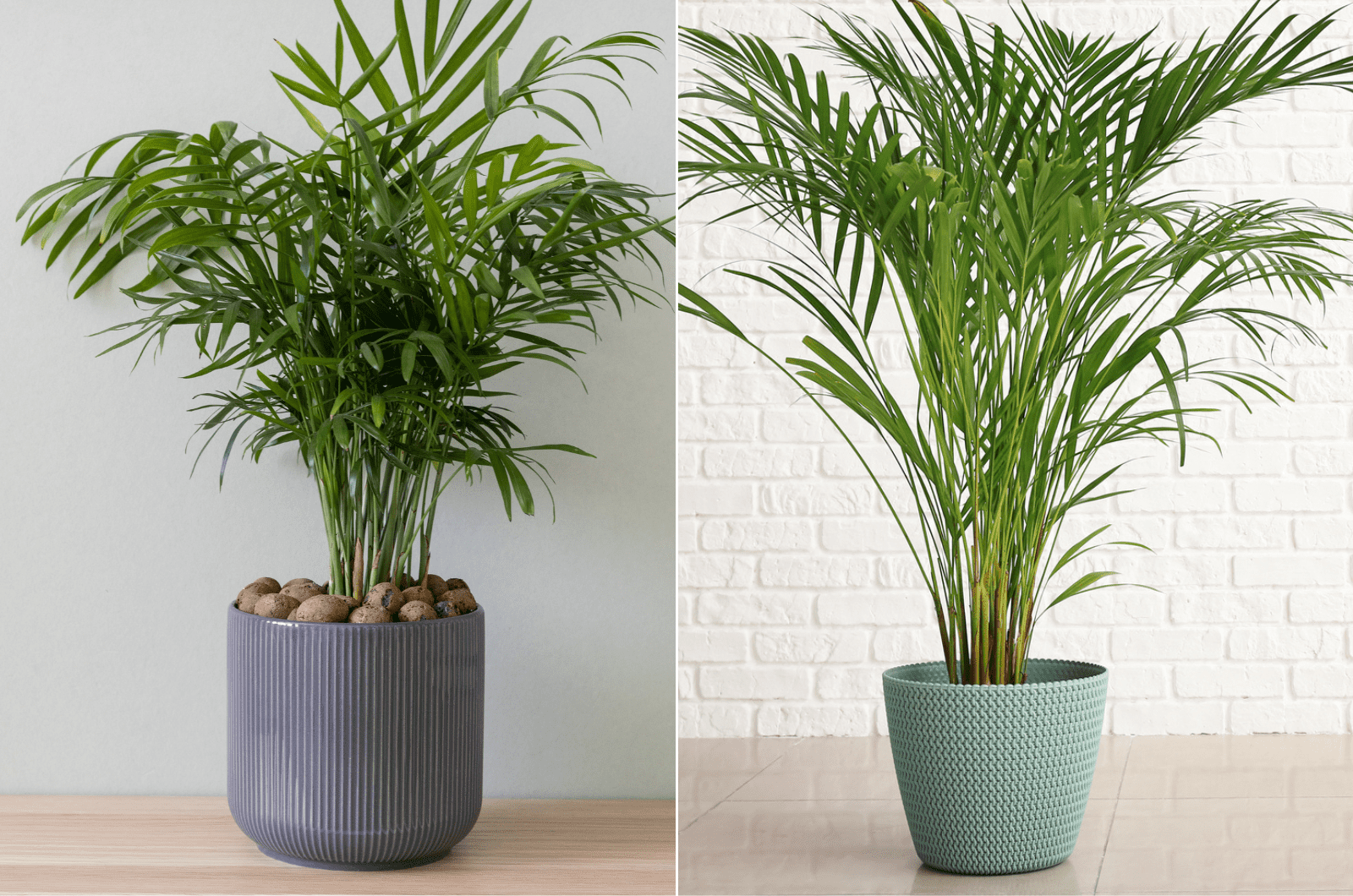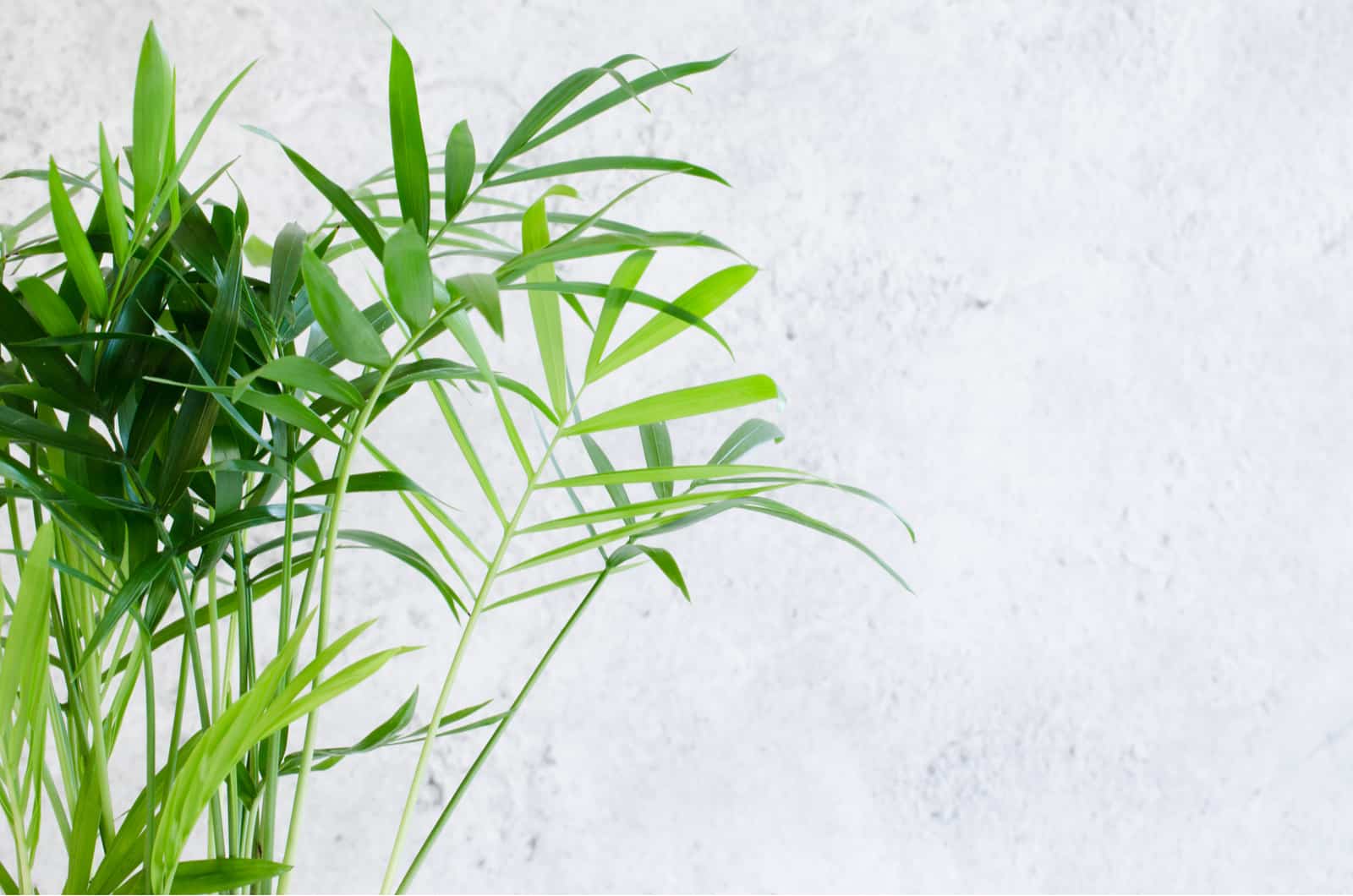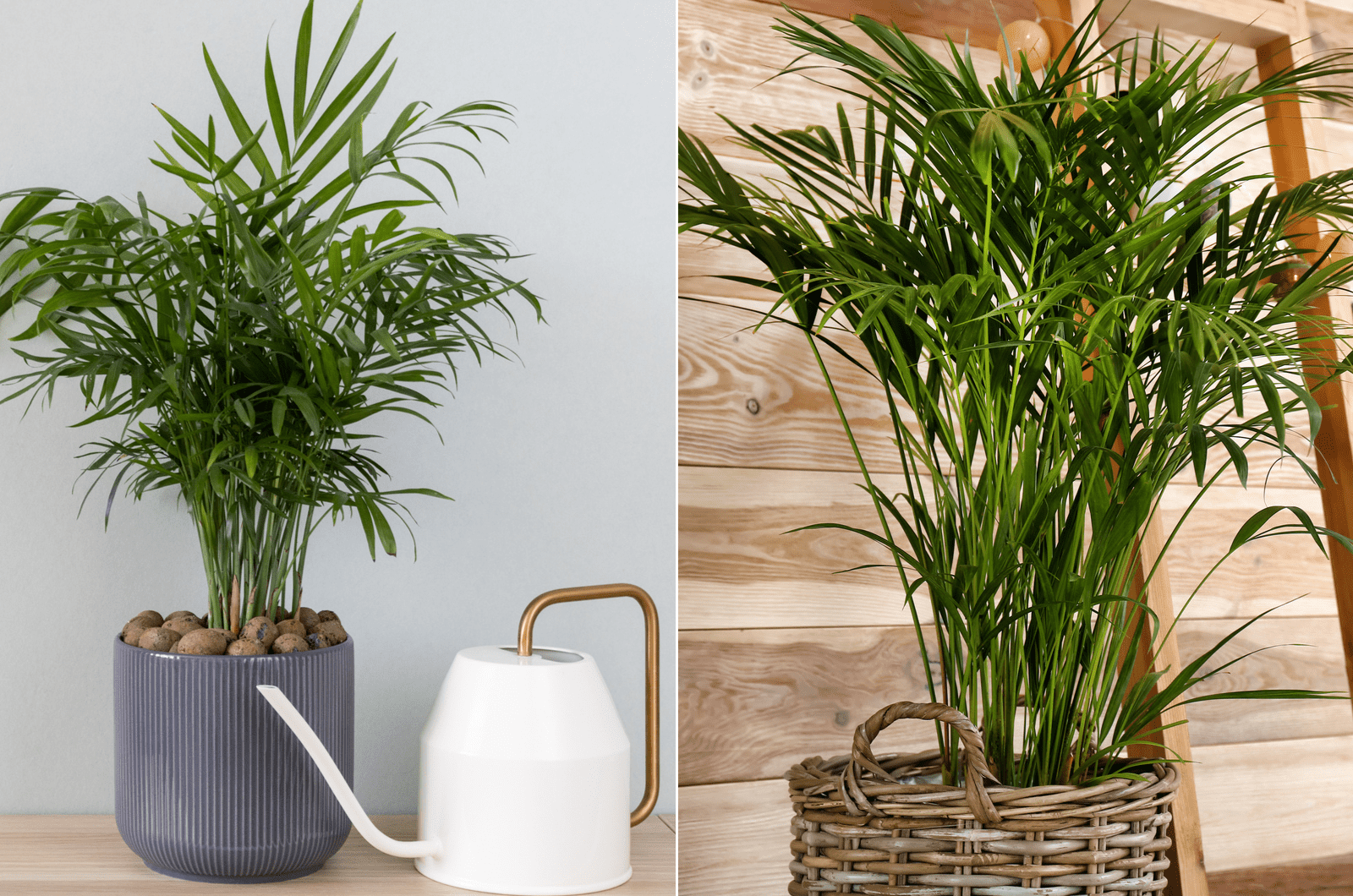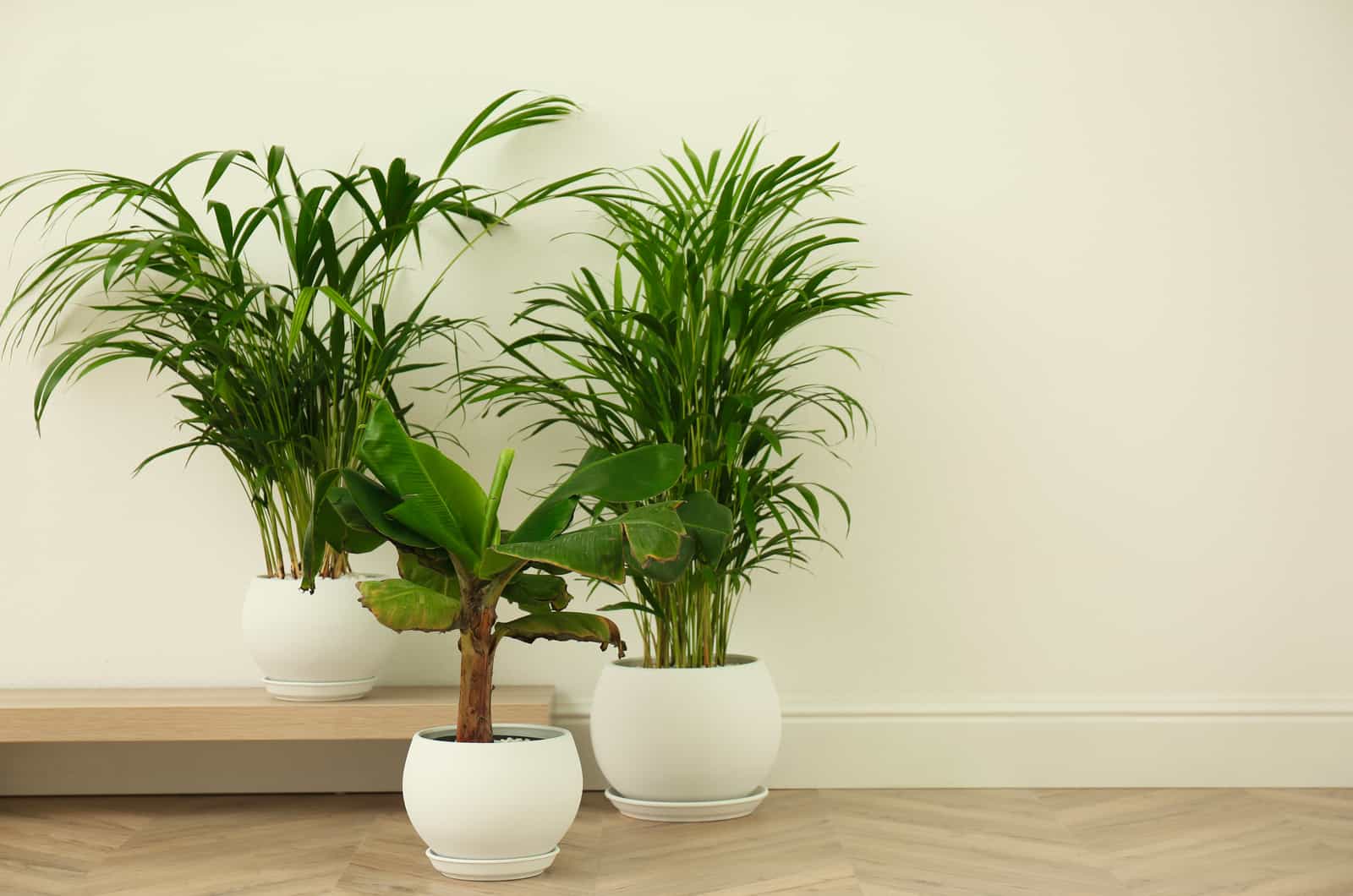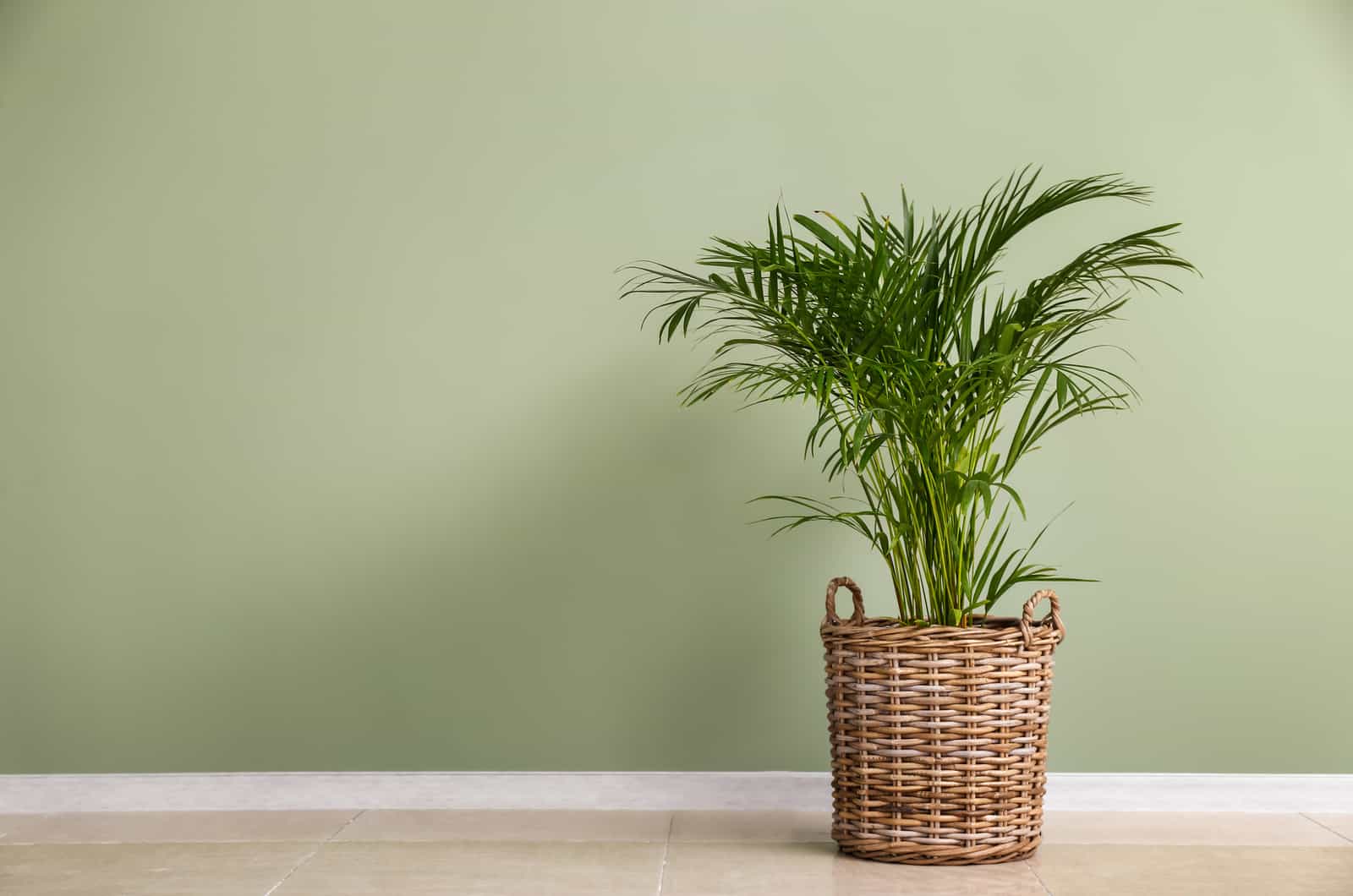Both the parlor palm and areca palm are ideal houseplants because they don’t require much care, but still give off an amazing vibe.
It might be challenging to choose between the two, not so much due to their similarity, but more because of their immense allure.
That said, these palm plants aren’t that similar, aside from having the term palm in their name, so differentiating between the parlor palm vs areca palm isn’t difficult at all.
There are four main differences that we’ll examine, and some of their similarities as well. Even though they aren’t physically similar, their care guides are pretty much the same.
They share common enemies in pests and diseases.
Let’s look into the main information about these plants before continuing:
| Scientific name: | Scientific term for parlor palm is Chamaedorea elegans, and for the areca plant it’s Dypsis lutescens |
| Native habitat: | Parlor palm is native to Central America, from northern Guatemala to southeastern Mexico, while areca palm is native to eastern Madagascar |
| Growth rate: | Both are slow growers, although areca palm can have moderate growth rate |
| Size: | Parlor palm can grow up to 2-6 feet tall indoors and 6-16 feet tall in its natural habitat, whereas areca palm can grow approximately 8 feet tall indoors and 12-30 feet tall in its natural habitat |
| Toxicity: | Both are non-toxic |
Parlor Palm vs Areca Palm
There are many physical differences between these two palms. As soon as you look at their fronds, you’ll know which one is which.
However, we’ll examine all the differences so you can decide which one will fit your decor better.
Before we continue, I want to mention these great quotes about palm trees that will make you feel like you’re on an island all by yourself sipping a pina colada straight out of a coconut!
Size And Shape
The first difference you’ll notice is their size. Areca palm is much taller than the parlor palm and can even reach 8 feet tall indoors. Therefore, you must consider the size of your room before choosing this indoor palm.
On the other hand, the parlor palm usually reaches 2-6 feet indoors and is perfect for small and large rooms alike. Also, it usually grows from multiple green clumps of stems, although a single-stemmed parlor palm isn’t uncommon either.
Areca palm also has many stalks, and its bamboo-like stems can be colored in shades of gold, which is why it is also known as golden cane palm or bamboo palm.
Leaf Color, Shape, And Texture
The Parlor palm’s light or dark green leaves are compound and feathery, ideal for any indoor space. Its lacy foliage can reach a size of 8 inches, but are still much smaller than those of areca palms.
Speaking of areca palms, they usually have dark, feathery fronds that are much more prominent than the leaves of the parlor palm. Areca leaves can grow up to 5.3-6.5 feet if conditions are favorable.
Also, one axil of the areca contains 40-60 pairs of leaflets, whereas the parlor palm usually has up to 40 pairs of leaflets. Areca palm foliage is V-shaped with a golden petiole, which is why designers all over the world adore it.
The texture of parlor palm leaves is delicate, but they are still a great addition to your decor and you only have to wipe the dust off them from time to time.
Finally, if your palm has yellow leaves it’s never a good sign, even though your areca can have yellow petioles (but never leaves). Discolored leaves usually signify underlying issues, such as too much or too little sunlight, overwatering or underwatering, nutrient deficiency, etc.
Flowers
Neither of these palm plants usually bloom when grown indoors. However, if the conditions are ideal they’ll adorn you with amazing flowers.
Parlor palm blossoms are small, yellow balls that appear on the stalks some time in late winter or early spring. They turn black when they’re ripe, and you can harvest them for seeds that you can plant.
Areca palm also has tiny, yellow flowers, but they appear in summer on two-feet long panicles and quickly turn to yellow-orange fruit about half an inch long. The fruit then darkens and becomes almost black, after which you can collect them and separate the seeds.
Background And Origin
Both of these tropical plants are native to rainforests, but they are very far apart.
Parlor palm is native to Guatemala and Mexico, whereas the areca palm‘s native habitat is limited to Madagascar. However, an areca palm can grow in many other places, such as Jamaica, Cuba, El Salvador, or anywhere its requirements are met.
Parlor palm is also called parlour palm and neanthe bella palm, and was quite popular in the Victorian era, where it was a common sight in many parlors (that’s how it got its name, right?).
Even though we don’t know in which era the areca palm was popular, it still has many other names. We already mentioned golden cane and bamboo palm, but it’s also referred to as butterfly palm, likely due to its large, serrated fronds.
Parlor Palm vs Areca Palm: Similarities
The following sections discuss the similarities between these two palms, and one is their care guide.
The other similarity we’ll talk about is a bit more pessimistic, but we’ll find something positive in it as well; the common pests and diseases that attack these plants.
The bad news is that they can fall ill and suffer from pest infestations, but the good news is that similar diseases and pests attack them, which means they require the same treatment (and prevention).
Both similarities can make your life a lot easier (especially if you have decided on growing both of these palms), so don’t skip the following sections!
Care Guide
Both of these slow-growing indoor plants are nothing like succulents, but are equally undemanding in terms of care.
They both require indirect light and a bit of water to thrive. However, there is more to plant care than just getting the light and water requirements right.
You need to think about the soil, humidity, fertilizer, preferred temperature, and even repotting. But don’t worry, because we’ll talk about all those things in the following sections. You’ll be able to grow stunning plants from the comfort of your home in no time!
Light
Both the parlor and areca palm require bright light, but you shouldn’t expose them to direct sunlight. They can even tolerate some low-light conditions, just as long as it’s not completely dark.
(No wonder the parlor palm is on the list of plants perfect for offices with no windows!)
Direct sun can burn these plants and hurt their leaves, so you should always strive to keep them a few feet away from windows, where they can enjoy indirect sunlight.
The Areca plant is slightly more tolerant of full sun conditions than the parlor plant, but you should still keep it away from direct light.
Unfortunately, there isn’t a cure for burnt leaves; you can only prune them and keep your plant away from bright sun rays.
You can place these palms in any room (as long as it’s not north-facing), you’ll just have to adjust the distance from the windows.
Water And Humidity
These palms don’t require too much water. You can irrigate them once or every other week if the temperatures aren’t particularly high.
However, you cannot always tell if your plant is thirsty just by looking at it or remembering when you last watered it. You must always check the topsoil before watering these palms, and if it’s not dry you should wait a day or two before checking it again.
Many things can go wrong if you have overwatered your palm tree, and you could be fighting a losing battle against discolored leaves, root rot, pests, and more before you know it.
You should water these plants more during their growing season than during their dormancy period because they use much more water. Also, the amount and frequency of water depend on other conditions. If your plants are exposed to more light and grow in places with higher temperatures, you should water them more than twice a month.
But if your region is quite humid, you might not need to water your plant more than once every two weeks.
Humidity
We’re already on the topic of humidity, so we might as well mention that these plants are native to tropical climates, which means they love high humidity.
You should invest in a humidifier or mist your plants’ leaves regularly if you don‘t want to see any leaves with brown tips.
You can get a good humidifier for a reasonable price on Amazon, or you can spray the palm leaves 3-4 times per week.
Pebble trays cannot raise the humidity enough, so they’re not the best option for these tropical plants, but you can always move them to more humid places in your home, such as bathrooms and kitchens.
Temperature
Both of these palm varieties thrive at room temperatures within the range of 60-75°F. Though they could probably endure slightly higher temperatures, don’t push them too hard.
Remember, if you’re not comfortable, your areca or parlor palm isn’t comfortable either!
Don’t let the temperatures drop below 50°F as that will truly harm your plant. It is native to the tropics, so try and mimic those temperatures the best you can.
Finally, you should avoid placing these palm trees below an AC or near heaters as they dry the air and create drafts, which these plants hate. Avoid drafty windows and places near doors for the same reason.
Soil And Fertilizer
These palms require fertile, loose, and well-draining growing mediums to thrive. You can get the ideal soil type from your local nursery, or you can make one yourself.
A homemade palm tree substrate should always contain potting soil mixed with peat moss because it retains water and prevents overwatering. Your plant can drink from the peat moss whenever it feels the need.
Add sand and bark to improve drainage and aeration, and make it heavy enough so that it can support your plant. You can also add some perlite to further improve drainage and prevent water-clogging.
Fertilizer
These plants aren’t what you’d call speedy growers, so naturally, we want to give them all the help we can to boost their development.
Therefore, you should fertilize these trees with a specialized palm tree fertilizer twice a year with a slow-release fertilizer, or once a month with a liquid fertilizer (you can dilute it if you’re afraid of over-fertilization or if it says so on the box).
Always feed your plants when they actively grow, which is in spring and summer, and reduce the amount or strength of fertilizers when the fall comes.
You don’t have to fertilize your plants during winter because that’s when they’re dormant and cannot use the nutrients you give them.
Repotting
The good news is that you don’t have to repot these palms very often because they’re not fast-growers.
However, you should change their soil and pot once they become potbound and you notice roots coming out of the container.
Thankfully, this rarely happens, and you can repot your plants once every 2-3 years. Find a larger pot (1-2 sizes bigger) and fill half of it with the potting mix.
Take your palm tree out of its container and remove the excess dirt around the roots. Now, move the plant into a new pot, add more soil to keep it in place, and gently pat it to make it more firm.
Water the new soil and move your plant to a bright area.
Finally, always repot your palm trees in spring because that will give them enough time to acclimate to the new pot and growing medium before winter arrives.
Pests And Diseases
Even though these palms don’t get infested as often as some other plants, they can fall victim to pest attacks.
The most common insects that nibble on the gorgeously green leaves of these plants are aphids, mealybugs, and spider mites.
Catching the infestation early will save you some trouble and your palms’ leaves from some holes!
You should monitor your palms consistently, and as soon as you notice a single bug, you should separate the infested plant from the rest and start treating it. If the infestation is small, you can remove the insects by hand or dip a Q-tip into rubbing alcohol to get rid of them.
However, larger infestations require insecticides, so don’t be afraid to use them.
Diseases
The most common disease that infects these plants is root rot. Root rot is caused by overwatering, and we tend to overwater plants whenever we hear the word tropical. Even though they like moisture, it doesn’t mean they want to be flooded with water, so you should be careful when irrigating them.
The best way to deal with root rot is to avoid it in the first place, but if the harm is already done there are a few things you can do.
The first is to inspect the roots if you notice something strange. Well, not just something; common symptoms of root rot are stunted growth, yellowing of the leaves, a droopy and wilted appearance, as well as a funky smell.
Once you’ve eliminated all the other possible causes, such as low-light or full sun conditions, underwatering, and low humidity, you should check the roots. Always touch the soil before disturbing your plant. If it’s dripping with water, your plant is probably infected.
You can confirm root rot by examining the roots; if they’re brown or black and mushy, your plant has fallen ill. Unfortunately, there’s not much you can do.
You should remove the infected roots and repot your plant into a new container with fresh soil, and ease up on the watering.
Other Palms For Indoors
Parlor palm and areca palm are simply stunning, but they’re not the only choices for improving your interior decor.
There are many other palm trees that would simply love to be a part of your home and decor, so let’s take a look at a few of them.
Cascade Palm
The care guide for the cascade palm is quite straightforward, and almost the same as the two palms we already mentioned.
The Latin name for this plant is Chamaedorea cataractarum, but it is also known as the cat palm and the cataract palm.
Its large, glossy, green leaves will introduce some freshness into your home and make a great companion for your other palms.
Kentia Palm
The botanical name of this plant is Howea forsteriana, and it is also known as thatch palm. It is a slow grower, but can get as large as the areca palm (so perfect for a pool decoration in milder climates).
Its dark frond looks terrific and it doesn’t require any special care. Just don’t expose it to too much or too little sunlight, be careful about overwatering, and plant it in well-draining soil.
Sago Palm
The Sago palm is scientifically known as Cycas revoluta, but it is not a true palm tree. It is actually a short, nut-producing cicada that grows from a trunk that doesn’t branch out.
Male and female plants differ in the shape of the cone they produce: the male plant has pineapple-like cones, whereas the cones of female plants are more round.
These cones not only look great, but also produce seeds after successful pollination, which you can use to propagate more palms.
Reed Palm
Reed palm, or Chamaedorea seifrizii, is your everyday palm tree. It’s also called cane palm and grows up to 6.5 feet indoors, which makes it an ideal addition to your living room and an excellent companion for a parlor palm.
Its simple, feathery, evergreen leaves look stunning and can even bloom tiny yellow flowers in ideal conditions.
Majesty Palm
Majesty palm is botanically known as Ravenea rivularis and is native to the island of Madagascar, where it can grow up to 100 feet tall! (A true royal.)
However, it won’t grow so tall in your home, so you don’t have to worry about it making a hole in your roof! Its bright green foliage complements modern decor, so don’t miss out on this one!
Lady Palm
Lady palm is also known as broadleaf palm due to its wide, dark green, and lustful foliage. It goes by the name Rhapis excelsa in the scientific world and forms dense clusters on slender stems.
It’s not as huge as some other palms, and its glossy, lance-like leaflets make it an attractive decoration for any home.
Ponytail Palm
Believe it or not, the ponytail palm is not actually a palm tree at all! It is a succulent, and it is even on the list of tall succulents.
It is a bold move to incorporate this plant into your home decor, but it pays off because it doesn’t require too much care and attention – it is a succulent, after all!
Chinese Fan Palm
This plant is known as Livistona chinensis in the scientific world and can be a great addition to your garden.
You can also grow it indoors and enjoy its fan-like foliage, or even take some and fan yourself while sitting beside a pool and eating some refreshing grapes!
Common Questions
Now that you have some base knowledge about parlor and areca palms, we can move on to answering some common questions about them.
These plants even have some benefits, so read on to find out more!
What are the benefits of parlor palms and areca palms?
Both palms are excellent air purifiers, and they increase oxygen levels indoors and eliminate carbon dioxide and monoxide up to a certain degree.
A NASA clean air study also proved that parlor palm (along with many other palm trees such as areca palm, lady palm, and plants in general) reduces harmful air pollutants indoors. Simply put, the plants’ roots destroy toxic substances and turn them into new tissue.
Both parlor and areca palms can reduce the amount of formaldehyde, benzene, and toluene in indoor air.
Also, the parlor palm and areca palm alike are non-toxic and safe for pets. They have a high transpiration rate, which means they can humidify the air around you and reduce headaches caused by dry air.
Dry air can also increase the symptoms of bronchitis and asthma, and even lead to skin wrinkling, so having one of these plants can be quite beneficial in the long run.
Finally, they are great for decoration and really easy to care for, which makes them all the more desirable.
Is parlor palm a palm tree?
Yes, the parlor palm is a true palm tree. Its leaf has a single petiole which supports many leaflets.
Don’t think that palm trees are just those trees you see in movies on tropical beaches. They can have one or multiple stems, but one of the most important characteristics is that palm trees don’t branch out.
Parlor palm grows from multiple stems which don’t branch, they just grow leaves on long petioles.
To Sum Up
Even though there are many differences between parlor palm vs areca palm, we still have difficulties differentiating between the two. However, we always look at their petioles, and if they’re golden we know we’re dealing with an areca palm.
And once they’re all grown up, no one could possibly confuse the parlor palm and areca palm!
The good news is that these plants have the same needs and deal with the same issues, so there won’t be much harm done if you can’t tell the difference between them.
Also, these are not the only palm trees you can use to decorate your indoor or outdoor areas, so we brought some of the most popular ornamental palms for you to choose from.
Finally, both plants have many benefits, such as purifying the air, oxygenizing it, and humidifying it.
And you can get all that by investing a minimum of care!
Happy planting, and enjoy your improved home decor!
Until next time!
Like this post? Share or pin it for later!

